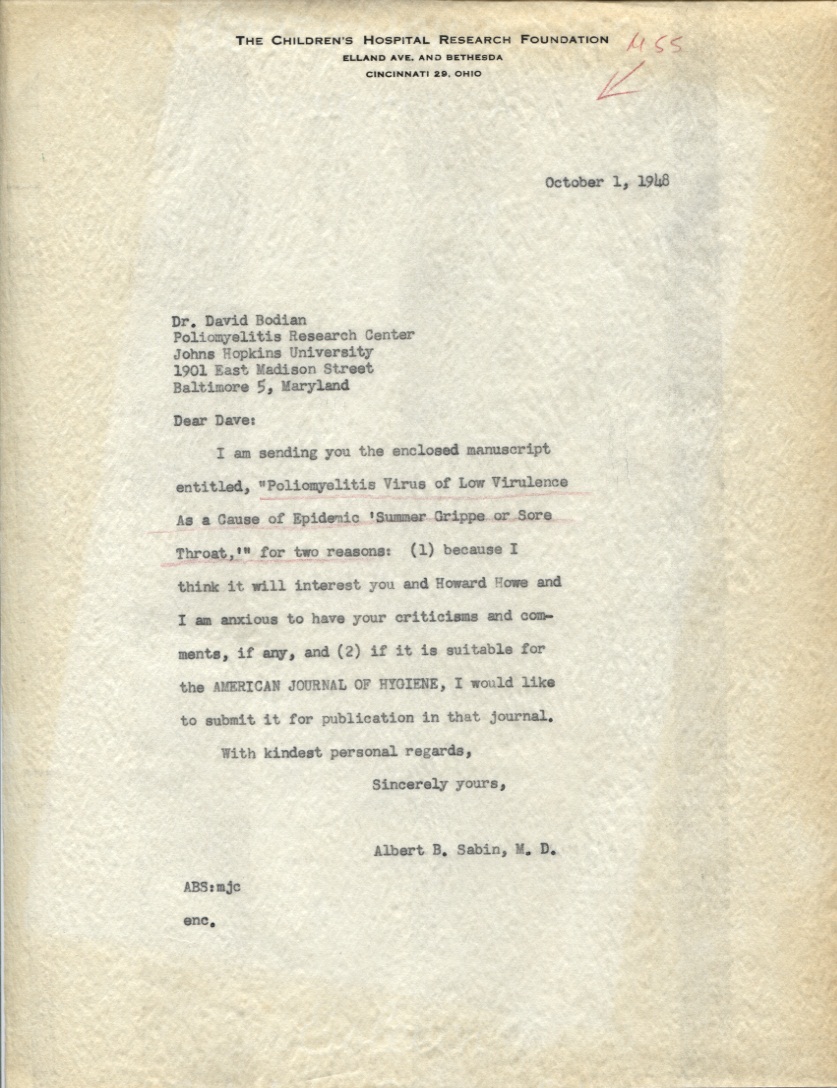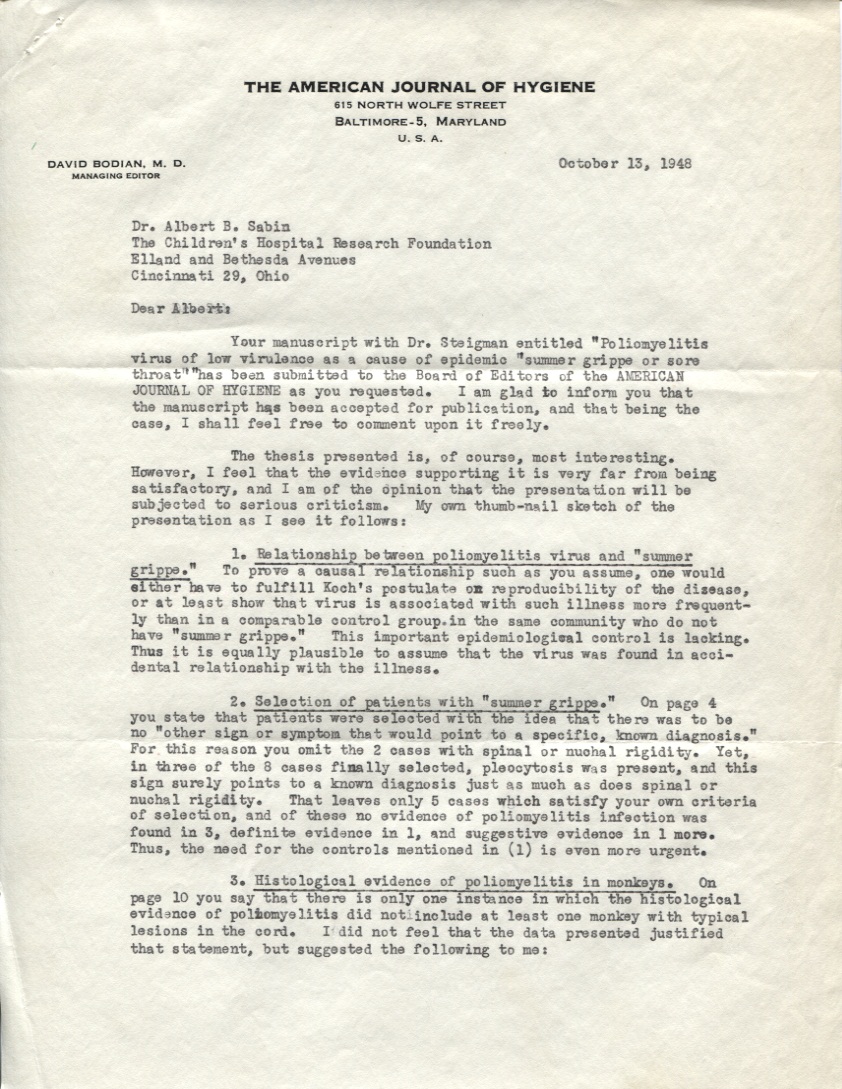The book The Polio Paradox: Uncovering the Hidden History of Polio to Understand and Treat “Post-Polio Syndrome” and Chronic Fatigue by Richard L. Bruno, H.D., Ph.D., has been sitting on my shelf for a while. I thought it would be interesting to tell you a bit about his discussion of Sabin, particularly because Dr. Bruno used the Sabin archives when he was researching this book.

October 1, 1948 - Letter from Dr. Sabin to Dr. Bodian, asking for comments on his article, as well as its appropriateness for the American Journal of Hygiene
For your information, Dr. Richard L. Bruno is the director of the Post-Polio Institute and the International Centre for Polio Education. He is known as an expert on Post-Polio Sequelae and has written several books and articles on the topic. His book tries to help people understand “Post-Polio Syndrome,” which the Mayo Clinic describes as “a cluster of potentially disabling signs and symptoms that appear decades — an average of 30 to 40 years — after the initial polio illness.”
Chapter 17 of the book, called “Fatigue by Any Other Name,” featured Dr. Sabin and his research on “Summer Grippe.” Dr. Bruno wrote that during the summer of 1947, over 10,000 cases of the disease occurred near Cincinnati. Sabin was curious about this disease because children often presented with a stiff neck, which was “the red-flag symptom that usually required immediate hospitalization and the terrifying diagnosis: ‘Poliomyelitis.’”[1] He and his colleague Dr. Alex Steigman collected specimens from several children in the Cincinnati area who were diagnosed with Summer Grippe and found the Lansing poliovirus strain in several of them. From his findings, Dr. Sabin concluded that “a kinder, gentler poliovirus” was the cause of this disease.[2]
Dr. Sabin and Dr. Steigman published an article called “Poliomyelitis Virus of Low Virulence in Patients with Epidemic ‘Summer Grippe or Sore Throat.’” Our collection contains several letters about this article, including some between Dr. Sabin and Dr. David Bodian and Dr. Howard Howe. David Bodian was a well-known polio researcher at Johns Hopkins University and editor of The American Journal of Hygiene. Howard Howe was one of Dr. Bodian’s colleagues at Johns Hopkins (and he was also mentioned in a previous blog post called “Famous Scientists.”)

October 13, 1948 - Letter from Dr. Bodian to Dr. Sabin, which includes criticisms mentioned in Dr. Bruno's book
Dr. Howe’s response to Dr. Sabin’s article provided suggestions, such as, “In the present instance I think that assurance is lacking, and for this reason it seems to me that you must prove up to the hilt that you are in reality dealing with poliomyelitis.” He also wrote that Dr. Isabel Morgan, another influential polio researcher at Johns Hopkins, suggested that Dr. Sabin should study this agent in “ordinary laboratory animals, used in fairly large numbers.” He ended the letter to Sabin saying, “It seems to me that these are basic things which must be done before one can proceed further. I trust you will not feel that I am being hyper-critical, but you did ask for my opinion and here it is.”[3]
According to Dr. Bruno’s book, Bodian criticized Dr. Sabin’s conclusion that a mild poliovirus caused Summer Grippe because he felt there wasn’t enough evidence presented in the paper. (The letter from Dr. Bodian quoted in Dr. Bruno’s book can be seen in part to the left.) The second page of the letter ended with Dr. Bodian saying, “I have made the above critique as strong as I could, first, because I know that you and Dr. Steigman can “take it”; and second, because I think the thesis is important enough so that it should have very good evidence to support it.”[4]
Dr. Sabin wrote back to Dr. Bodian a couple days later with additional information for the various points in Bodian’s letter. He wrote, “Our meaning of the present title of the paper is intended to suggest consideration of poliomyelitis virus of low virulence as a cause of, etc., etc. However, it is obvious that it can be interpreted otherwise” (emphasis is Sabin’s.) This exchange prompted Dr. Sabin to change the title of the article from “Poliomyelitis Virus of Low Virulence As a Cause of Epidemic ‘Summer Grippe or Sore Throat’” to the final title listed above. [5]
According to Dr. Bruno, other cases similar to the Summer Grippe occurred that would help Dr. Sabin support his argument. In 1948, over 1100 people in Iceland came down with “Iceland Disease,” which had similar symptoms to polio, but also “tingling, numbness, and ‘general tiredness.’”[6] Dr. Sabin’s 1959 oral polio vaccine study in Singapore helped to solidify his theory. Through the study, it was determined that the Singapore children “were protected from getting paralytic polio because a mild Type II poliovirus elbowed-out the high-virulent Type I poliovirus.”[7]
If you are interested in learning more about Dr. Bruno’s research in post-polio syndrome, the Winkler Center owns a copy of The Polio Paradox (call number WC 555 B898p 2002). Feel free to contact the Center at chhp@uc.edu or (513) 558-5120 for more information.
References
[1] Bruno, Richard L., The Polio Paradox: Uncovering the Hidden History of Polio to Understand and Treat “Post-Polio Syndrome” and Chronic Fatigue (New York: Warner Books, 2002), 277.
[2] Bruno, 278.
[3] Letter from Dr. Howe to Dr. Sabin, 12 October 1948.
[4] Letter from Dr. Bodian to Dr. Sabin, 13 October 1948.
[5] Letter from Dr. Sabin to Dr. Bodian, 20 October 1948.
[6] Bruno, 280.
[7] Bruno, 281.
Note: All of these letters can be found in Series #3 – Manuscripts, Box #8, Folder #10 – (142) Poliomyelitis of Low Virulence in Patients with Epidemic “Summer Grippe or Sore Throat.”
In 2010, the University of Cincinnati Libraries received a $314,258 grant from the National Endowment for the Humanities (NEH) to digitize the correspondence and photographs of Dr. Albert B. Sabin. This digitization project has been designated a NEH “We the People” project, an initiative to encourage and strengthen the teaching, study, and understanding of American history and culture through the support of projects that explore significant events and themes in our nation’s history and culture and that advance knowledge of the principles that define America. Any views, findings, conclusions, or recommendations expressed in this blog do not necessarily reflect those of the National Endowment for the Humanities.
